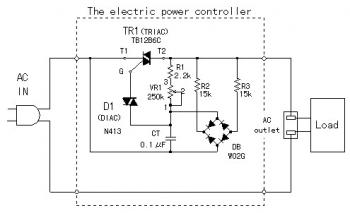This is an electric power controller which implemented the bidirectional triode thyristor(TRIAC). This circuit can manage the electrical power using the a single variable resistor.
This circuit is applied for the dimmer which adjusts the light from the bulb. This circuit adjusts the quantity of the electrical current which flows via the load together with the bidirectional triode thyristor and controls the electric power. It truly is only the alternating voltage that may be controlled with this circuit and it is impossible to perform the control in the DC voltage.
Simply because it controls the passing time in the alternating current by the bidirectional triode thyristor, the electrical current which flows via the load is not the clean sine wave type. Due to the fact it's, there is limitation in the equipment which may be controlled with this circuit. The bidirectional triode thyristor is usually called by the trade name TRIAC.
The equipment which can be controlled
- The equipment which works by the resistance. Such as the the tungsten-filament lamp, the soldering iron and so on.
- The equipment which is using the AC series motor(with the brush). Such as the drill, the electric fan, the cleaner and so on.
The equipment which can not do the control
- The fluorescence light.
- The synchronous motor(using the capacitor)
Detailed Electronic Power Controller Circuit project: http://www.piclist.com/images/www/hobby_elec/e_ckt24.htm

Comments